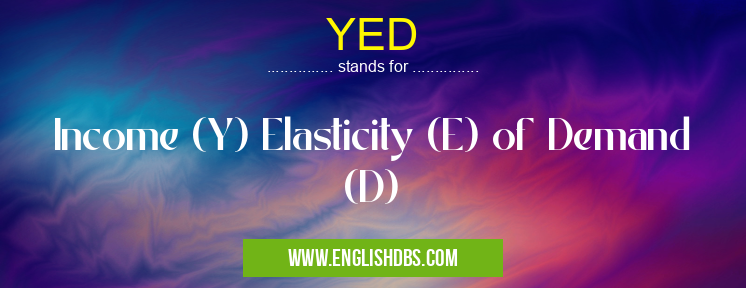What does YED mean in GENERAL
Income Elasticity of Demand (YED) is an important concept in economics that measures the change in demand for a specific good or service in response to changes in consumer income. YED measures the amount by which the quantity demanded of a good or service will vary with a one-percent change in real income, given all other factors that influence demand remain constant. It provides an indication of how sensitive consumers are to changes in their disposible incomes and can be used as an indicator of spending patterns and consumer behaviour within the market.

YED meaning in General in Business
YED mostly used in an acronym General in Category Business that means Income (Y) Elasticity (E) of Demand (D)
Shorthand: YED,
Full Form: Income (Y) Elasticity (E) of Demand (D)
For more information of "Income (Y) Elasticity (E) of Demand (D)", see the section below.
How is it Calculated?
YED is typically calculated using regression techniques, which use historical data to estimate future trends in consumption based on past trends. The calculation involves comparing two variables - income and demand — over a certain period of time, then looking at the correlation between them. This correlation indicates how sensitive demand is to changes in income, allowing economists to calculate an effective elasticity value for each good or service studied.
Essential Questions and Answers on Income (Y) Elasticity (E) of Demand (D) in "BUSINESS»GENERALBUS"
What is Income Elasticity of Demand?
Income Elasticity of Demand (YED) measures how demand for a good or service changes when the income level of consumers increases or decreases. In other words, it measures how much the quantity bought changes relative to a change in income. This elasticity can help businesses understand how to price products and services, develop marketing strategies, and make predictions about future trends in the market.
How is YED Calculated?
YED is calculated by taking the percentage change in quantity demanded divided by the percentage change in income. This equation can be expressed as follows: YED = (% Change in Quantity Demanded)/(% Change in Income).
What are Examples of Goods with High YED?
Goods that have high YED tend to be luxury items such as expensive cars, designer clothing, and exotic vacation packages. These goods become more attractive to consumers when they get an increase in income because they can afford to purchase them now.
What are Examples of Goods with Low YED?
Goods that have low YED tend to be necessities such as food and fuel. These goods tend not to become more attractive to consumers even when their income increases because no matter what the price level is, people still need these items for sustenance or transport.
Does Higher Prices Mean Higher YED?
Not necessarily. It depends on how consumers respond financially to higher prices. If they respond less than proportionally then that would mean lower YED despite higher prices; if they respond more than proportionally then that would mean higher YED despite higher prices.
Can Different Types of Consumers Have Different Levels of YED?
Absolutely. Different types of consumers may display different levels of financial responsiveness towards different types of goods, meaning different customers will display different levels of YED depending on their individual circumstances and preferences.
Is Higher or Lower YED Better for Businesses?
That depends on the situation; if businesses are looking for rapid sales growth then a high elasticity will generally benefit them since it suggests demand is very responsive to changing incomes; however if businesses want steady long-term sales then a low elasticity may be preferred since it suggests customers' needs do not fluctuate too drastically due to temporary economic conditions such as recessions or spikes in inflation.
Can Other Factors Affect the Value of Income Elasticity Of Demand?
Yes; other factors such as availability of substitutes, consumer perception & taste as well as consumer disposable income can also play a role in determining the value & direction of demand elasticity.
Is There Any Way To Predict Changes In The Value Of Income Elasticity Of Demand Over Time?
Yes; through analyzing factors such as demographic shifts, economic conditions & consumer preferences we can reasonably estimate future value & direction changes in demand elasticities over time.
How Do Businesses Utilize Knowledge Of Income Elasticity Of Demand?
Businesses utilize knowledge about Income Elasticity Of Demand (YED) to optimise pricing strategies and product/service offerings according to current trends & anticipated future developments in consumer needs & tastes.
Final Words:
Income Elasticity of Demand provides valuable information about consumer behavior and spending patterns by measuring how drastically our demand for goods and services fluctuates with changes to our disposable income levels. By understanding this concept better, economists can identify which sectors are likely to experience economic growth or decline depending on shifts in consumer discretionary spending power. Knowing this information helps businesses make better decisions on where they need to focus their efforts and resources so that they can maximize profits while still providing valuable products and services to their customers.
